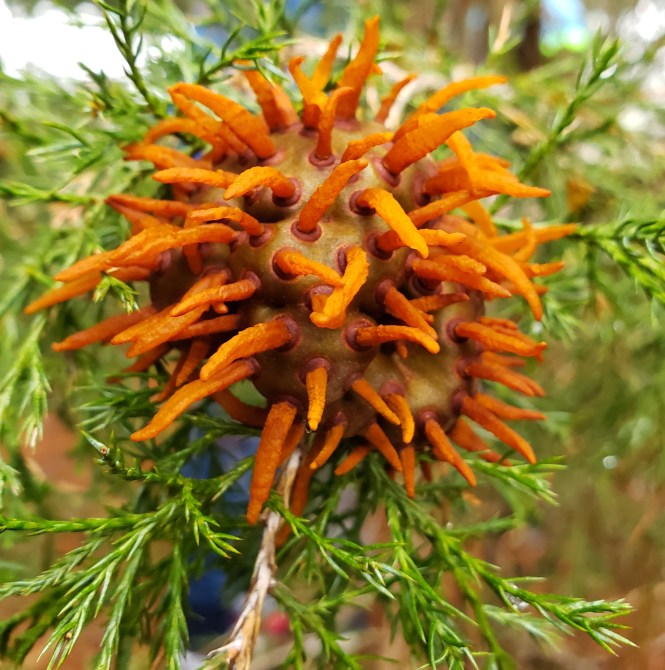
What Is This?:
A friend of mine found one of these in her yard and sent me an email asking if I knew what it was. I had seen the later stage of this creature last year when I was mowing my lawn out back growing on a cedar tree. After a little research I found that it was Cedar-Apple Rust fungus.
Is This Christmas?
After seeing her picture, I decided to go out an see if my tree had any of these growing in my yard. When I reached the large cedar tree in my backyard I found what looked like a Christmas tree ornamented in orange and brown spiky balls. Needless to say, I was impressed with how successful this group of fungi is in reproducing more of its own kind.
Here are some more pictures of what I found:
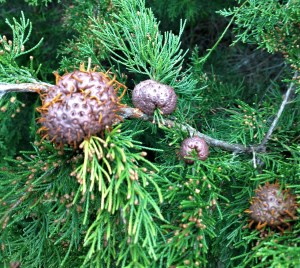
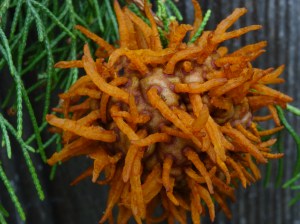
It Takes Two to Tangle!
While doing research on this organism I found out it takes two different hosts for it to complete its reproductive cycle, one from at least two different families of plants. Some of the plants that can serve as hosts are the Chokecherry, Mountain Ash, Service Berry, Hawthorn, Pears, Crab Apples, Juniper, Cypress, Quince, Service Berry, Apples, and many members of the Rose Family.
So Where Do They Come From?:
Even though these unusual creatures look like aliens from outer space, they are actually common residents of the Eastern United States. They actually look very different in their various stages of development. It usually takes two years for them to complete a cycle. They start out with tiny spores that drift on the wind once they are released from another host’s parasitic infection. Once they land on the plant the spores send out little root like structures that bury into the stems of other plants. It takes about 7 months until the organism is noticeable. The stem region starts to swell up to form a gall. After about 18 months these swellings start to form gelatinous golf ball like structures. These are brown, as you can see in some of these pictures.
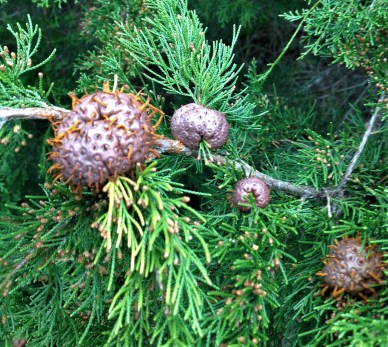
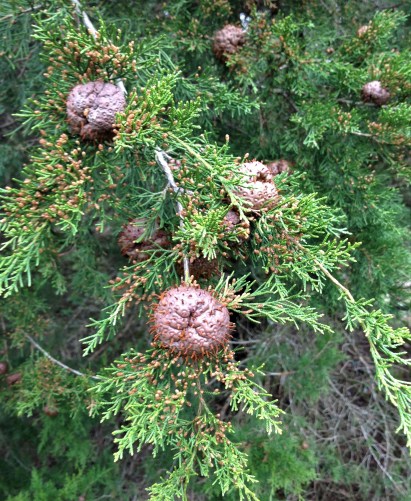
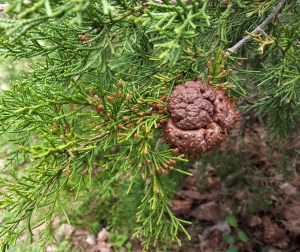
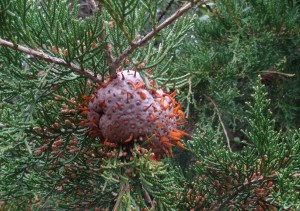
They Turn Orange With the Spring Rains:
After a couple warm Spring rainfalls the little brown balls start to depress around the surface. From these depressions come little finger-like projections. These eventually turn bright orange on the outermost ends of the extensions. Scientists call these reproductive structures “Telial Horns”. It is this part that holds the spores that will be released after they are formed. Interestingly these structures can emerge several times on the same gall, ( 5-7 times) during the course of the Spring and early summer.
Are They Dangerous?:
Though these creatures look dangerous they actually do no harm to humans and little harm to the trees they infest. It is the fruit that suffers. Those that tend apple orchards are the ones that fear this fungus the most. They would not be happy if you planted a Cedar tree near their orchards. When the spores travel to the apple and pear trees, as well as the others mentioned above, they become noticeable first on the leaves.
Easy to Spot:
If you were to see red, or brown spots showing up on the leaves of your trees you would know that the fungus has arrived. Most farmers will have already sprayed their trees with fungicide prior to this development. Others prune out the infected branches quickly to prevent its spread. Most farmers select fungal resistant varieties of fruit trees to also slow its progress.
What’s In a Name?:
These creatures go by a variety of names but the most important one is the scientific name: “Gymnosporangium juniper-virginianae” .
They are in a Family of fungi known as “Pucciniaceae”. The most common name is “Cedar-apple Rust”. The rusty part is how they look when they start to dry out and release the spores.
Why Not Do Some Further Research?:
If you live in the Eastern part of the United States, why not go out and check the trees around your neighborhood? You can also see many pictures of this fungus and find more information on many of the agricultural web sites on-line.
Consider the Design:
Whenever I discover something new in God’s Creation I’m reminded of just how well designed each organism is in relation to its survival. Some organisms have very complex life cycles. All organisms are dependent on their relationships with others.

Irreducible Complexity:
There is also complexity in all the parts that make up the whole: the cells, tissues, organs, and systems that combine to form the organism. For each step of this design to work there is irreducible complexity. The organism could not survive unless all the parts were there at the same time. This is why I believe it was all designed by the Master Creator. As you go through the next week, think about this concept every time you see another living organism. God designed it all as a way of showing us His divine power and purpose. He enjoys seeing us considering His care in how everything He created functions. He wants all of us to know He loves us and has a purpose for our lives. Do you know Him?
Very interesting! Thanks for taking the time to put all this information out there!
LikeLike
I love how you encourage thought about the irreducible complexity our Creator put into His creation so we would know He made it all with a plan and purpose, too. 🙂
LikeLike
Nice photos and research. I learned something. We have a lot of this in SE Iowa right now.
LikeLike